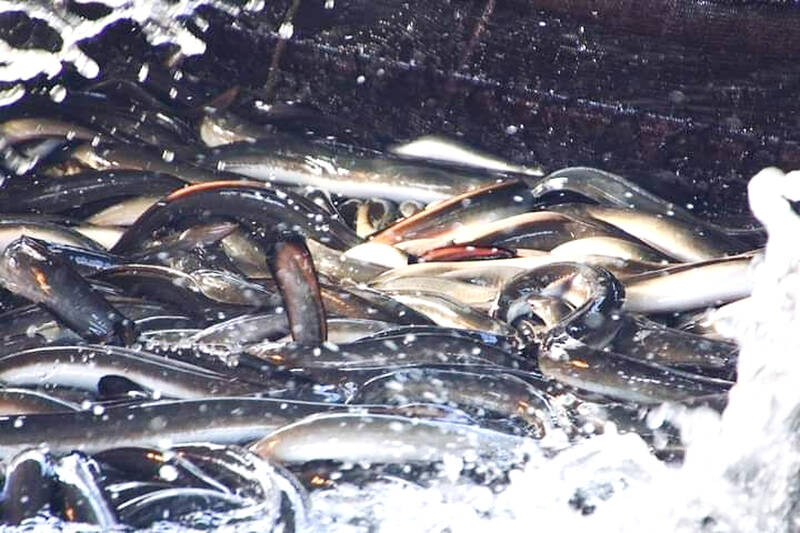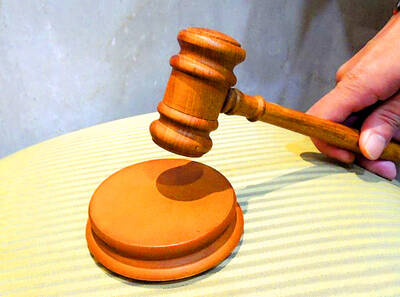Eel production in Taiwan has slipped behind that of other East Asian nations over the past few years, leaving producers looking for alternatives to the formerly lucrative export market.
Once the regional leader in eel production, Taiwan’s release of fry into farming ponds has fallen far behind Japan, China and South Korea.
Taiwan leads off eel harvest season in East Asia, which typically runs from Nov. 1 to the end of February the following year.

Photo : Tsai Tsung-hsun, Taipei Times
To supply Japan for “unagi day” in midsummer, eel fry must be released before the middle of January, making Taiwan the best place to supply its neighbor during the high season.
However, Japanese producers have in recent years begun purchasing eel fry from Taiwan at high prices to supply their domestic market, driving down Taiwan’s eel exports and breeding industry.
As a result, the market share of Taiwanese eel in Japan and the amount of fry released into farming ponds has been falling rapidly.
Taiwan only accounted for 1.2 percent of eel fry released in East Asia, at 320kg, the Nihon Yoshoku Shimbun, a Japanese trade journal focusing on the eel industry, reported on April 7.
Japan led the industry at 49.3 percent (13,553kg), followed by China at 32.7 percent (9,000kg) and South Korea at 16.9 percent (4,639kg).
Owing to China’s recent success in the industry, South Korea has begun importing significant quantities of fry from China and Hong Kong to boost its numbers, making Taiwan’s market share likely to fall below 1 percent, the publication said.
Taiwan’s eel exports had already begun to slide before the COVID-19 pandemic. Exports fell each year between 2018 and last year, from 2,396 tonnes to 1,654 tonnes during the period.
July was the most productive month each year, ranging from 182 tonnes in 2020 to 410 tonnes in 2018.
The worst hit to fry rearing came over the past two years, from 8,143.8kg in 2020 to 4,430.49kg in 2021, and only 877.33kg last year.
This year, only 320kg has been released.
Eel farming in Taiwan is being depressed by high fry prices and dwindling exports, Taiwan Association of Eel and Shrimp Production Cooperatives chairman Tang Ching-tsung (唐慶宗) said.
As the risk is high, farmers are reducing their stock, making their exports less competitive and continuing the downward cycle, Tang said.
The way to correct the problem is to keep harvested fry in Taiwan to replenish domestic farming ponds in preparation for Japan’s “unagi day,” he said.
Farmer Kuo Hung-yu (郭紘瑜) said that he used to frequently send large eel orders to Japan, but now only sends one or two containers at lower prices.
Most eel producers are waiting to see what might happen, Kuo said, adding that his strategy is to stabilize revenue by actively pursuing domestic buyers before seeking more export opportunities.
Farmer Tang Hsin-yuan (唐昕遠), who is newer to the business, agreed that fry are expensive and exporting to Japan is not cost-effective.
He is only rearing enough this year to satisfy domestic demand and is converting idle ponds to more competitive species.
Tang said that if he stuck with only rearing eel, there is a good chance he would lose money despite the great effort required.

‘DENIAL DEFENSE’: The US would increase its military presence with uncrewed ships, and submarines, while boosting defense in the Indo-Pacific, a Pete Hegseth memo said The US is reorienting its military strategy to focus primarily on deterring a potential Chinese invasion of Taiwan, a memo signed by US Secretary of Defense Pete Hegseth showed. The memo also called on Taiwan to increase its defense spending. The document, known as the “Interim National Defense Strategic Guidance,” was distributed this month and detailed the national defense plans of US President Donald Trump’s administration, an article in the Washington Post said on Saturday. It outlines how the US can prepare for a potential war with China and defend itself from threats in the “near abroad,” including Greenland and the Panama

A wild live dugong was found in Taiwan for the first time in 88 years, after it was accidentally caught by a fisher’s net on Tuesday in Yilan County’s Fenniaolin (粉鳥林). This is the first sighting of the species in Taiwan since 1937, having already been considered “extinct” in the country and considered as “vulnerable” by the International Union for Conservation of Nature. A fisher surnamed Chen (陳) went to Fenniaolin to collect the fish in his netting, but instead caught a 3m long, 500kg dugong. The fisher released the animal back into the wild, not realizing it was an endangered species at

The High Prosecutors’ Office yesterday withdrew an appeal against the acquittal of a former bank manager 22 years after his death, marking Taiwan’s first instance of prosecutors rendering posthumous justice to a wrongfully convicted defendant. Chu Ching-en (諸慶恩) — formerly a manager at the Taipei branch of BNP Paribas — was in 1999 accused by Weng Mao-chung (翁茂鍾), then-president of Chia Her Industrial Co, of forging a request for a fixed deposit of US$10 million by I-Hwa Industrial Co, a subsidiary of Chia Her, which was used as collateral. Chu was ruled not guilty in the first trial, but was found guilty

The Chinese Nationalist Party (KMT) is maintaining close ties with Beijing, the Democratic Progressive Party (DPP) said yesterday, hours after a new round of Chinese military drills in the Taiwan Strait began. Political parties in a democracy have a responsibility to be loyal to the nation and defend its sovereignty, DPP spokesman Justin Wu (吳崢) told a news conference in Taipei. His comments came hours after Beijing announced via Chinese state media that the Chinese People’s Liberation Army’s Eastern Theater Command was holding large-scale drills simulating a multi-pronged attack on Taiwan. Contrary to the KMT’s claims that it is staunchly anti-communist, KMT Deputy